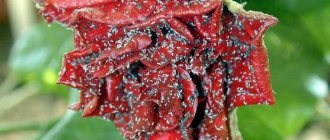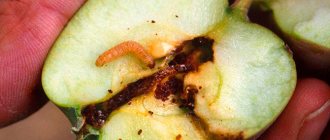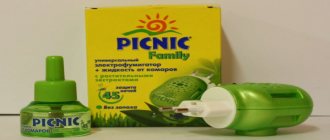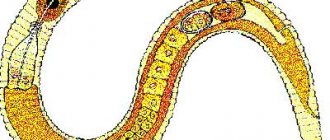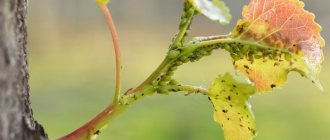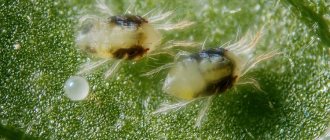Author's rating
Author of the article
Yakov Pavlovich
Professor, Head of the Department of Vegetable Growing
Articles written
153
The leaves contain many amino acids, which are a natural bait for insects. You can get rid of aphids and prevent the spread of parasites using folk remedies, chemicals, and mechanical methods. A gardener must know how to deal with aphids on an apple tree. Otherwise, the pests fly to other plants. The risk of destruction of green spaces is increasing.
Common types of aphids
The insect is small: its size is no more than 7 mm. This is a representative of the phytophagous family with a proboscis for sucking juice from plant crops. By piercing the cell with a piercing mouthpart, it feeds on its juice.
During the life of aphids, honeydew (decomposition products) , containing many sugary substances. A variety of insects flock to it: flies, bees, wasps. Ants love her very much .
There are different types of aphids, their color depends on the plant they parasitize: light green, dark green, black, gray, orange, light pink. There are a huge number of aphid species. On fruit trees and apple trees live:
- Red-headed or gray aphid;
- Green apple moth;
- Green rose moth.
Its characteristic features:
- The body is 2 mm long, green with white antennae and a red head;
- The overwintering place for eggs is the bark of an apple tree;
- In spring, females hatch from the eggs - the founders of the future colony on this tree;
- Females are capable of hatching up to 50 larvae. They begin to parasitize on the lower part of the leaf blade;
- A second wave of winged females hatch in June, with a black body and green belly;
- The next generation produces a new offspring of winged and wingless individuals of both sexes;
- In September, aphids develop especially actively.
Attention! A colony of ants will help the pest settle on the apple tree. Honeydew (honeydew) is a tasty delicacy for them. Ants guard and protect aphids; they monitor the growth of the colony. Therefore, the fight against aphids on an apple tree also includes the fight against ants .
Settling on different parts of the tree, aphids crawl and fly from place to place. And where it stops “for a while”, the plant begins to have serious problems and you must know how to protect the apple tree from aphids.
Means of struggle
Typically, aphids appear on those apple trees that grow on soils deficient in phosphorus, magnesium and boron, but with an excess of readily available “organic” nitrogen. Don't forget that fertilizing the soil is a very important aspect of garden care and you can overdo it when trying to “improve” the soil.
Therefore, it happened that the gardener only had to feed the apple trees with a decoction of superphosphate with the addition of borax or apply the missing nutrients to the leaves, while cutting off the tips of the apple tree branches with a cluster of aphids , and the problem disappeared for the whole summer.
But sometimes there were particularly difficult years when there were literally “outbreaks” in the number of aphids. At this point it was necessary to look for other culprits of this disgrace, namely ants. After all, the main “breeder” of aphids is ants , they feed on their sweet juice and in order to obtain such nutrition they increase their “livestock”.
Therefore, the main stage in the fight against aphids will be steps to simultaneously exterminate both aphids and ants. Trap strips on the trunk of apple trees a good
Often this is old agrofibre with a pungent smelling substance, for example, a carbolic solution or oil infused with anise fruits.
Ant hunting belts.
If the apple trees are young or dwarf, then their trunks are generously rubbed with green parts of onions or garlic arrows, and such trees become unpopular with ants.
But if all non-poisonous methods do not work, then there is only one thing left - to use natural poisons . They help a lot:
- Tobacco decoction;
- Infusion of hot pepper;
- Wormwood spray.
Attention! When using natural poisons, you must protect your respiratory organs and eyes, because They are dangerous for humans too!
If synthetic poisons are needed, then for private and country apple orchards, poisons containing substances that are least dangerous to nature and the apple tree :
- Carbosulfan;
- Thiacloprid;
- Thiamethoxam.
Watch the video on how to fight aphids on an apple tree in the summer:
Photo of aphids on an apple tree:
Gray apple aphid.
Roseate green aphid.
Green apple aphid.
Signs of a pest
Understanding which pest has “attacked” your garden is not that difficult.
- Red swellings appear on the leaves;
- The leaves on the apple tree curl, turn black and dry out;
- The shoots stop growing;
- The tops of the apple tree are twisted;
- A sticky honeydew appears on them, onto which the ants crawl.
Honeydew formed during the life of aphids.
The aphids continue to move through the tree. It begins to parasitize on the apical part, so you may not be able to detect it right away. It leaves behind exhausted and weak shoots and leaves. Finding aphids is quite simple: you need to turn over a leaf, and a colony of small green insects will appear in front of you. The presence of ants on an apple tree can also alert you and force you to examine it carefully.
You should know it! Aphids not only parasitize apple trees, they also carry viral infections , which can cause serious damage to cultivated plants. In addition, it causes serious damage to young crops .
So, we found out that there are aphids on the apple tree in your garden - what to do? Fighting aphids is not easy: the reproduction process is fast and constant. To actively kill insects, you can use both folk and traditional preparations and modern chemicals. In addition, there are natural helpers.
Where does it appear on trees?
Aphids are harmful insects that love leaves, shoots and tree bark. If the tree is attacked at an early age, this may subsequently cause its deformation, the leaves will wither and fall off, and the buds will be seriously delayed in development.
Affected fruit trees produce very small sized fruits and they will likely fall before they have time to ripen to the desired level. Crops also become less resistant to temperature changes, and their frost resistance decreases by an order of magnitude.
Aphids not only drink all the juices from the plant, but also leave secretions, which are a good basis for the proliferation of fungi and various viruses. She herself can be a carrier of such diseases, and they are dangerous for animals and people.
Among the reasons why this insect appears in the garden, the first is its spread in neighboring areas adjacent to the site. But you don’t have to worry about this issue if there are ladybugs and a number of other insects in the garden that are dangerous for the aphids themselves and of which they are afraid.
Aphids on an apple tree
If fruit trees receive fertilizer in large excess, their leaves become very thin, this is an additional advantage for the appearance of the pest.
Pear Elegant Efimova
The female, after the fertilization process, begins laying eggs. She does this to those places that are most difficult to reach and invisible. The eggs spend the winter period calmly, because they are additionally protected by ants, who subsequently carry them to different plants. From these eggs wingless females emerge; these individuals reproduce even without fertilization. They are the producers of the bulk of worker aphids.
At the very end of May or beginning of June, other adults appear. These are females that can fly. They are engaged in spreading pests over long distances. With the help of the wind, they are able to cover quite large areas, tens of kilometers.
There are cases when aphids suddenly disappear and then reappear. This is explained by the fact that at first the aphid, which is called dioecious, reproduces on some crops, and then, when females capable of flying appear, it moves to other plants. Towards the end of summer they again return to their former habitat.
Insect eggs are distinguished by their ability to tolerate fairly cold temperatures, spending the winter on a tree trunk.
For your information. Common ants help spread aphids on apple trees. The sweet syrup secreted by aphids is ant food. Therefore, ants take care of the eggs and can protect them from various insects.
The apple tree is attacked by this insect for the following reasons:
- The leaves of the plant have too high a content of amino acids;
- Lack of phosphorus and potassium;
- Excess nitrogen;
- Finding an anthill in close proximity to a tree.
Natural allies in the fight against aphids
It would be good if it were not us who had to deal with pests, but their natural enemies . And aphids do have such enemies, so treating apple trees against aphids with chemicals is not always justified.
Insects that eat aphids include: hoverflies, ladybugs, lacewings, earwigs, wasps, ground beetles and other predatory garden inhabitants. To attract them, fragrant herbs are grown in the garden.
The ladybug is a natural enemy of aphids.
Aphids are eaten by small birds or serve as food for chicks. Sparrows, tits, wrens, wrens, and linnets are not averse to eating the pest for lunch. They also need to be attracted to your plot: make birdhouses, put up drinking bowls.
Wren is another assistant in the fight against aphids.
Attention! Treatment with pesticides is prohibited if you use biological methods to control aphids.
There are also plants that contain phytoncides , which repel aphids. These are herbs with a strong aroma :
- Marigold;
- Coriander;
- Garlic;
- Mint;
- Basil;
- Lavender;
- And others.
In small groups they can be placed in the garden area.
How can you spray apple trees against aphids without chemicals? Biological control methods also include special preparations. Biological “medicines” are more environmentally friendly. They contain extracts from plants and herbs.
Most gardeners prefer preparations of this series. Actarin and Actofit help against aphids . They can be used both during flowering and during budding and fruit set, because they will not cause harm.
Ants and aphids on an apple tree: how to fight with folk remedies?
Let's start with traditional (folk) methods of struggle, because chemical “medicines” will saturate both apple trees and the ground. And ultimately they will end up (partially) in our bodies. Created on the basis of laundry soap and herbs, such methods are considered the most effective.
| Name of the infusion | Cooking method |
| Tobacco infusion | Use 500 g of tobacco, 30-40 g of laundry soap per 20 liters of water. Tobacco leaves are infused in 10 liters of warm water for 2-3 days. The solution is filtered and the remaining water is added. The laundry soap is crushed and mixed well with the solution. The soap is needed to help the solution stick to the leaves. |
| Yarrow infusion | Take 700-800 g of yarrow, 40 g of laundry soap and 10 liters. water. The grass is poured with boiling water and allowed to stand for several days. Then soap is added and diluted in it. |
| Ash use | Use 3 cups of ash, 40g. laundry soap, 10l. water. Ash and grated soap are diluted in warm water. Let it brew for two days. Using this recipe will not only get rid of aphids, but will also work as foliar feeding. |
| Tomato tops | Take 5 kg of green leaves, add 10 liters. hot water and 30 min. boil. Prepare the solution in the required proportions: 1 liter. decoction – 3l. water. Before use, add soap (30 g of soap per 10 liters of water). |
| Hot pepper | 100g. fresh pods are boiled in 1 liter. water, let it brew for 2 days, filter. The resulting concentrated solution is diluted 1:10. 40g of soap are diluted into 10 liters of water. |
Attention! A 10-liter bucket of infusion is enough to spray 5 fruit trees. Any solution prepared for the first time must first be tested on a small area to ensure its effectiveness. You need to use a fine spray to treat the lower part of the leaf blade.
Infusions from plants, despite their composition, can be dangerous :
- Cause a burn on the leaves (if a high concentration of solution is used);
- Posing a danger not only to the pest, but also to the beneficial inhabitants of the garden;
- Some of them are poisonous to humans.
The method that was used by our grandfathers and great-grandfathers is fumigation with tobacco smoke :
- Take a bucket or large tin and light a fire from the twigs;
- The fire flares up and you need to pour tobacco dust into it;
- You place the container so that the white smoke hits the trees;
- You smoke for several hours;
- When the smoke disappears, the aphids will die.
You should know it! If no control measures are taken, the aphid will produce 50 generations over the summer, causing damage to absolutely healthy crops.
Approximately 450 species of leaf aphids are among the most serious agricultural pests.
Mechanical protection methods
For physical traps and baits, trapping belts . To do this, take masking tape and wrap it around the trunk (about half a meter from the ground). A sticky layer of glue against rodents and insects is applied to it around the circumference of the trunk.
Disadvantage: on hot days the glue drips.
a layer of foam rubber around the barrel below the masking tape lubricate its upper part . This method is more reliable. Neither ants nor aphids will be able to climb the trunk.
There are several agricultural techniques on how to save an apple tree from ants and aphids, but they are ineffective :
- Weeding and garden digging;
- Removing aphids from foliage by hand;
- Rinse off with a powerful stream of water.
Preventative measures can also be used. Such, for example, as fighting ants , attracting natural enemies to the site .
Attention! Do not overfeed the tree with nitrogen fertilizers, because it is young greenery that attracts aphids.
How to prevent infection of neighboring trees?
Aphids quickly spread throughout the area and should be removed at the first sign of infestation. It is better to immediately remove severely damaged shoots and burn them along with the insects.
What measures protect against the spread of aphids throughout the area:
- Mowing grass in tree trunk circles, removing weeds throughout the entire area. The young shoots of the apple tree are dug up as soon as they grow, since aphids especially love young foliage.
- Whitewashing and cleaning of tree trunks. Removal of peeling bark is carried out regularly to prevent egg laying. Trees need to be whitened with lime in winter; it protects plants from many pests. The trunks are cleaned with a stiff brush, the wounds are coated with iron sulfate and pitch. Whiten by adding copper sulfate to lime.
- Do not allow ants to multiply excessively in the area, monitor the population. Complete destruction is not recommended - ants help pollinate plants when there is a lack of other insects. Sprinkle circles around apple trees with dry mustard and tobacco, destroy anthills near the tree.
- Pruning trees in a timely manner, do not thicken the crowns, do not allow garden crops to combine into a common mass, and maintain a sanitary distance. This will facilitate ventilation, air flow, and will prevent aphids from infecting all plantings at once.
- Do not exceed the norm for applying nitrogen fertilizers. Excess nitrogen weakens the defenses of apple trees. Nitrogen fertilizing is carried out no later than the beginning of summer.
The soil acidity and composition of microelements recommended for crops should be maintained. Good nutrition helps garden trees resist pests.
Any protective measures do not help to completely avoid aphid infestation. Insects fly from neighboring areas and cannot be stopped. Folk remedies can be used to carry out preventive spraying of apple trees and other garden crops. Then single pests will not be able to cause much damage, a total infestation of aphids will not occur, and the use of insecticides will not be required.
Use of chemicals
When all possibilities have been exhausted and knowledge of how to get rid of aphids on an apple tree using folk remedies has not helped, and the aphids continue to eat young leaves of the apple tree, we move on to “heavy weapons” - chemicals. These include drugs of contact, intestinal or joint action .
| Drug name | Action |
| Aktellik | It has a contact and partially systemic effect. Sold in ampoules. Spraying is done with a freshly prepared solution, which is evenly applied to the leaves. Hazard class 2: may cause harm to people or animals |
| Aktara | Spray 2 times a week apart. After 30 min. after exposure, insects stop feeding and die after 24 hours. Hazard class 3, toxic to a number of insects. |
| Inta-vir | The impact is intestinal and contact. Available in tablets. Treat the apple tree three times if the aphids appear again. Apple trees are treated before flowering. |
| Spark | The action is intestinal and contact. Tablet form. Spraying is one-time, repeated (if the insects are not destroyed) is carried out after 20 days. Danger level: moderate |
| Confidor | The systemic drug, which enters the culture through all its organs, is not washed off by rain. The effect is observed several hours after treatment. Protects the tree for 15-30 days. |
Attention! Spraying should be carried out in closed overalls if the weather is without wind or rain. After treatment, dispose of any remaining product, wash your hands and face, and change clothes.
Green and red gall aphids
Ants on an apple tree how to fight
Green apple aphids are recognized as one of the most harmful parasites for this tree. It is an insect whose length is no more than 3 mm, with a green or yellowish color. The female lays eggs in the buds of the plant; she is capable of producing about 100 black eggs, each of which is no more than half a millimeter in size.
Yarrow for your garden
Its larvae are born at the very beginning of spring and very soon crawl into a bud that has already blossomed. With their thin proboscis they drink all the juices from it. Green aphids also eat shoots and leaves of the plant. Aphids are attacked by a number of insects and birds, but this is not enough to completely destroy the pest.
An equally dangerous insect that causes very serious damage to apple orchards is the red gall aphid. It can attack various varieties of these fruit trees. At the same time, it damages the fruits to such an extent, leaving behind red spots that there is no need to talk about any commercial appearance of apples.
This aphid looks like a wide oval, almost a circle. The length of females is only 2 mm. The color can be either green or gray.
Males can be even smaller in size - about 1.5 mm. They have black stripes across their abdomen.
Male aphids
The eggs that the red gall aphid lays are initially yellow, but after a short period of time, about 3 days, they change color to a paler shade of yellow.
She begins active actions when the foliage blooms. The born larvae settle on the leaves, usually on their underside. The leaves begin to thicken at the edges, become rougher, and then curl. Red or pink mounds appear. Leaves that are heavily influenced by the pest eventually dry out and die.
Before the plants flower, the females of this species are more fertile, producing up to 70 larvae, and later - only up to 15 larvae. Approximately 4 generations occur during one season. In June, males capable of flying and females without wings appear in red gall aphid colonies.
Processing apple trees in different seasons and flowering phases
Now you know how to treat an apple tree against aphids and ants, and you need to decide when to do it. It is best to apply pest control treatments in early spring .
- In spring : chemical is carried out before the buds open. The bark, where pest eggs overwinter, also needs to be treated. During the period of budding and at the end of flowering - infusions and decoctions ;
- In summer , mechanical and agrotechnical methods are used biological plant protection products (preparations and insects) are used;
- In autumn : infusions and decoctions - 14-40 days before removing apples from the tree. Physical methods : pruning affected and old branches, burning foliage. Treatment of apple tree bark with chemicals (overwintering areas for eggs) can be carried out after leaf fall .
Aphids are a dangerous pest. But today there are many methods to combat it. The main thing is not to miss the time when the “unexpected guest” appears and start processing on time.
You can find out more about the fight against aphids in the video below:
